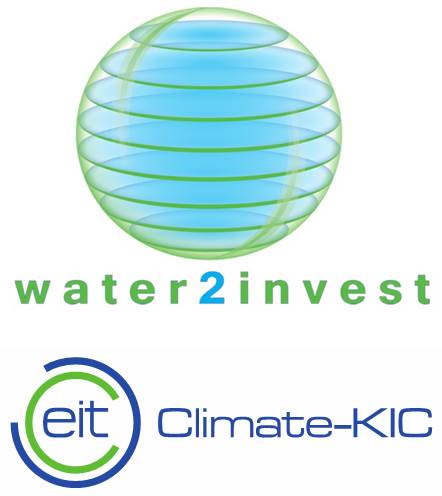To adapt to a changing climate governments, regional development banks, international donors and investors require information on where adaptation measures are most effective and most feasible in a specific context. To make information more easily accessible to end users, the Climate-KIC innovation project Water2Invest developed an offline and online tool. In this project a regional validation and demonstration of the Water2Invest tool is carried out. The validation and demonstration focuses on three different key regions, each in a very different geographical context but all with a high need for climate adaptation investments. Besides the regional end-users, the project also reaches out to other potential customers for regional applications of Water2Invest such as the World Bank and regional development banks.
To adapt to a changing climate, large investments are required across the globe. The World Bank (2010), estimates required investments in the range of USD 70-100 billion annually in developing countries, and the global total cost of potential climate change damage are tenfold this amount. Governments, regional development banks, international donors and investors require information on where adaptation measures are most effective and most feasible in a specific context. More specifically, policymakers and investors need the following information:
- Insight in current and future water scarcity and socio-economic and environmental impacts
- Effectiveness of a wide range of possible adaptation measures
- Possibilities to zoom in from a global scoping level of analysis to a regional assessment
- Rapid economic assessment of effectiveness of possible investments
To make information more easily accessible to end users, the Climate-KIC supported innovation project Water2Invest developed an offline and online tool to access results from a global model (PCR-GLOBWB , and WatCAM ). Water2invest combines established modelling frameworks to quickly analyse the effectiveness and impacts of interventions to address water scarcity under different future scenarios at global and regional scales. Unique is the approach to use so-called “water provinces”: regional units that combine the hydrological realism with the decision making administrative units. The tool combines computations of water availability and water demand, taking account of existing infrastructure and operational rule, and translates results into indicators for cost-effectiveness, and for societal and environmental impacts. Users can adjust model settings to customize computations. Additional functionalities with regard to assessing tailor-made water infrastructure interventions, information on effects and impacts, aggregation level and comparison and presentation options are currently under development.
 The envisaged business model for Water2Invest included a ‘fremium’ model with some information available for free and other information available against charge. The freely available information focuses on basic information for global scoping level analysis. This information includes insight in future water shortages per type of water user, effectiveness of different measures and a first indication of financing possibilities for these measures at the level of individual water provinces (intersection of countries and river basins). The ‘premium’ version will provide more detailed information, such as more information on costs and benefits of measures, and on investments possibilities and barriers, and enhanced functionalities to aggregated and compare data. Both versions were intended to be available as on-line as well as off-line versions.
The envisaged business model for Water2Invest included a ‘fremium’ model with some information available for free and other information available against charge. The freely available information focuses on basic information for global scoping level analysis. This information includes insight in future water shortages per type of water user, effectiveness of different measures and a first indication of financing possibilities for these measures at the level of individual water provinces (intersection of countries and river basins). The ‘premium’ version will provide more detailed information, such as more information on costs and benefits of measures, and on investments possibilities and barriers, and enhanced functionalities to aggregated and compare data. Both versions were intended to be available as on-line as well as off-line versions.
To make the step towards a “premium” business model, it is necessary to carry out a regional validation and demonstration. The tool should be applied and fine-tuned for a more detailed analysis, focusing on a few case study regions and together with potential end-users in this region. This validation and demonstration should be performed together with potential users to meet their needs, requirements and willingness to pay. A regional detailed assessment on effectiveness of measures and investment prioritization in which end-users are directly involved, should demonstrate the fitness of the tool and enable full market exploitation. Specific attention will be paid to the demonstration of the so-called “water marginal cost curves” that allow prioritization of climate adaptation investment portfolios and that are a direct output of the Water2Invest tool.
The validation and demonstration will focus on three different key regions, each in a very different geographical context but all with a high need for climate adaptation investments:
- Incomati basin, Mozambique. Potential end-user: ARA-Sul
- Segura and Jucar basin, Spain. Potential end-user: Segura and Jucar water authority
- Upper-Indus basin. Potential end-user: World Bank through its Upper-Indus initiative.
Besides these end-users, the project will also reach out to other potential customers for regional applications of Water2Invest: World Bank, Regional development banks (Asian Development Bank, African Development Bank, European Investment Bank) as they finance large (non-)infrastructural measures for climate adaptation in these regions.
Publicaciones relacionadas
2016 - FutureWater Report 157
Large scale adaptation strategies to climate change in the water-sector: An overview of the water allocation model WatCAM
Buitink, J., J.E. Hunink, P. Droogers, P. Torfs

